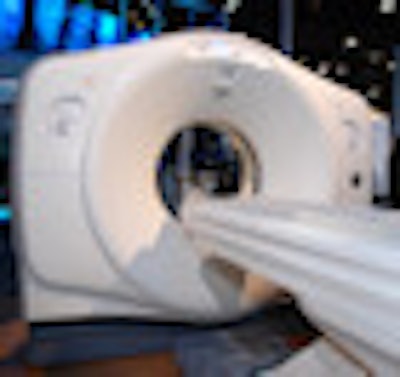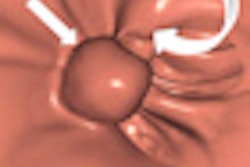
Today's CT scanner market boasts the widest array of CT scanner models, capabilities, and pricing options in history. But all that choice can be overwhelming. In an October 17 webinar, nonprofit research organization ECRI Institute offered some guidance on how to cut through the clutter.
The virtual session, hosted by Jason Lauders, ECRI senior project officer and medical physicist, along with Robert Maliff, director of ECRI's applied solutions group, included presentations on the various available scanners and emerging CT technologies (Lauders), as well as a talk on other considerations involved in choosing a particular scanner (Maliff). The following are highlights of the talks.
Scanners and features
CT scanners today can cost anywhere from $350,000 to about $1.5 million, and the key to picking the right one lies in its potential use. At the low end, 16-detector-row scanners can be acquired for $350,000 to $400,000, and "prices are dropping all the time," Lauders said.
But despite the falling prices, 16-slice technology is far from dead, and sales have even picked up a bit. For many sites that mostly perform routine applications such as body imaging, 16 slices are all they really need. What you can't expect is to perform advanced applications or readily upgrade, he said.
Over the past several years, a shift in the industry with recent advances in technology has meant that "how many slices your scanner has is becoming less important than other technical considerations," Lauders said. It's important to look at other factors including total anatomic coverage, the number of data channels, and advanced technologies that can maximize specific applications.
Siting costs matter, as well as seemingly mundane factors such as the amount of air conditioning and electricity you'll need, because they can make a big difference in your total budget. When water cooling isn't available, air conditioning needs rise substantially, Lauders said.
The anatomic coverage in a single rotation -- from 3 to 4 cm for a typical 64-detector-row machine to 16 cm for a premium 320-detector-row machine -- affects how long a patient needs to remain still during the scan. All other settings being equal, a 16-detector-row scanner takes about twice as long to scan the same region as a 64-slice machine, he said. Anatomic coverage also affects the amount of contrast, the degree of x-ray tube heating, and radiation dose. In the 16-detector-row scanners, larger patients and those who move around are not well accommodated, and these scanners are the last to get the latest dose-reduction tools.
The difference in gantry rotation times, from less than a third of a second to about a half-second, makes more difference than one might think, Lauders said. Still, the difference is only really critical for applications such as cardiac imaging, which you're never going to do on a scanner with fewer than 64 detector rows in the first place, he said. Generator power is an important variable to look at and is critical for advanced applications. But its importance is fading in the era of dose-reduction technologies and vastly improved image-processing schemes.
As for radiation dose, its importance only keeps growing, both in clinical practice and in buyers' minds. Virtually every system sold today comes with dose modulation, and every system also reports the dose, which wasn't the case three to four years ago, Lauders said. If you're feature-shopping, look for DICOM Dose SR, which reports dose events, and NEMA XR-25, which enables scanners to produce dose-related notifications to alert operators before scanning if the estimated dose would exceed the preset levels.
Other features to consider
Closely connected to dose is iterative reconstruction, a data reconstruction protocol for reducing dose. Iterative reconstruction isn't available on every system; manufacturers generally reserve it for their premium systems and offer it as add-ons for other systems, he said.
One step up from 16-detector-row machines are the 20- to 40-slice models that at least offer some ability to upgrade, Lauders said. Sales of the workhorse 64-detector-row scanners, the mainstay of CT imaging for the past several years, have fallen recently in favor of the 128-slice machines. The latter lack the advanced features of premium scanner models, but do offer improved image quality over 64-detector-row machines, as well as some advanced features.
"The 128s haven't got everything that the premiums have -- they don't have the latest applications -- but they do have much improved abilities, especially when it comes to 3D, compared to the 64s," Lauders said. "Some of the latest technology is becoming available in the [128-slice] marketplace."
The highest-level premium CT models, costing up to $1.5 million, have the very latest technologies, including iterative reconstruction, cutting-edge dose reduction technologies, body perfusion technology, and more. On the downside, he said, they're expensive, require training for centers to get the most out of their investment, and suffer from underutilization in that some of their features may never be used often enough to justify the investment.
"If you're a research place, you'll definitely be interested in buying one of these [premium scanners], but for a hospital that really just wants to do the best for its patients without wasting money on these machines, [128 detector rows] is probably more than you require," he said.
Technological developments to track
Technological development in CT scanners can be categorized into three broad areas: dose control, improvements in existing technologies, and emerging developments, Lauders said.
Dose control includes iterative reconstruction, dose monitoring, and user controls. Iterative reconstruction can cut radiation dose as much as 75% and is available on a wide array of scanners models, though the newest algorithms tend to be available only on the premium models.
Examples include the following:
- GE Healthcare offers its most advanced algorithm, Veo, as an option only on the top-end Discovery CT750 HD system, while the older adaptive statistical iterative reconstruction (ASIR) algorithm is standard on all other systems.
- Philips Healthcare's iDose is available on all models except its MX-16.
- Siemens Healthcare's advanced sinogram affirmed iterative reconstruction (SAFIRE) algorithm is available on all models except the Emotion, which is limited to the older iterative reconstruction in image space (IRIS) algorithm.
- Toshiba Medical Systems' new adaptive iterative dose reduction (AIDR) 3D is an option on its Aquilion One, Premium, and Prime RXL models.
"Iterative reconstruction is a very powerful tool becoming available today," Lauders said. Dose monitoring is the other huge technology becoming available. If you don't have it you should look into getting it, but "be prepared to spend significant sums of money to do it properly," he said.
Most manufacturers are also developing dose monitoring programs, with some third-party availability. DICOM Dose SR is available on most scanners and NEMA XR-25 is becoming widely available. The goal for the next several years is to centralize dose monitoring for all modalities.
More attention is also being paid to improving existing applications, especially cardiac imaging, where tools are being developed improve acquisition and boost temporal resolution, for example by using postprocessing software to unblur images.
Other new tools reduce imaging blooming, distinguish plaque types, and support perfusion imaging. Much of the development is taking place in dual-source CT technology, Lauders said, and as is often the case, the most advanced techniques are often available only on premium scanner models. In stroke imaging, perfusion CT is being made easier, and scanners with wide area coverage are favored. New metal artifact reduction techniques work very well.
Body perfusion for oncology is another fast-emerging area, with studies published utilizing techniques in the liver, pancreas, lung, and colon. Gauging by the number of studies, interest is growing fast, and technology is making it easier to use. Questions remain about the doses involved and how it will be used beyond its current home in research, but the potential is very broad, he said.
Finally, "dual-energy imaging is really growing in interest" of late, Lauders said, with studies being published in several areas, including kidney stones and gout imaging, discriminating calcium (bone) versus iodine (contrast agent), bone removal, and cardiac perfusion, with more automated processing software becoming available. Dual-energy platforms include GE Discovery CT 750 HD, Siemens Somatom Definition Flash, Siemens Definition Edge, and Philips iCT.
"GE and Siemens are a little further down the line than their competitors," Lauders said. More scanners are getting the ability, and there are huge differences in the technology, but it's definitely an area you're going to have to look at in the future, and I think five years from now, dual-energy will be very widespread and will be used routinely in most hospitals."
CT technology is something to pay attention to in the coming years, Lauders said. "CT hasn't finished yet."
1 | 2



















